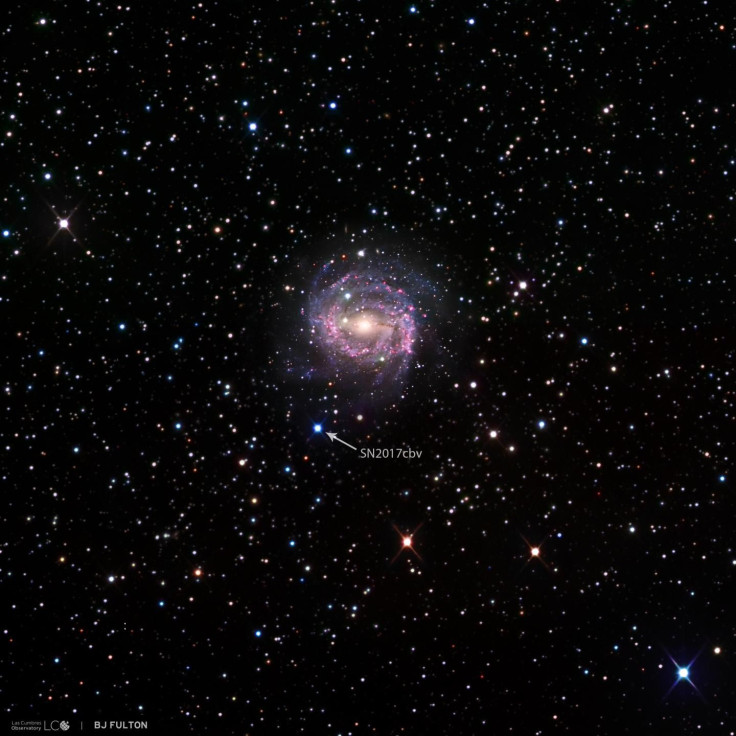Early Detection Of Type Ia Supernovae Finds White Dwarf’s Companion Star

Scientists have known for long now than a Type Ia supernova is primarily a white dwarf star in a binary system collapsing in on itself and then exploding. And while these stellar explosions have been used to measure the pace of acceleration at which the universe is expanding, astronomers were not sure at all about the nature of the other star in the binary system, which could either be a gigantic star an even smaller white dwarf than the one that exploded.
However, the early detection of a Type Ia supernova earlier this year could have narrowed that down significantly. On March 10, an assistant professor at the University of Arizona, David Sand, spotted a Type Ia supernova 55 million light-years away from Earth. It was not only one of the closest supernovae seen in recent years, but also one of the earliest to be seen after exploding.
“This was one of the earliest catches ever — within a day, perhaps even hours, of its explosion,” Sand said in a statement Monday, speaking of the supernova that is called SN 2017cbv and is located in the galaxy NGC 5643.
This early spotting of the supernova explosion — which appeared as a star-like bright object in the sky in a place where there was no star previously — allowed researchers to observe it near-continuously. The observations of the explosion’s immediate aftermath showed “a small bump in the light curve emitted by SN 2017cbv within the first three to four days,” according to the statement issued by the university.
Of the two candidates for the supernova’s companion star — a gigantic star and another white dwarf — the observations suggest it was the former.
“The bump in the light curve could be caused by material from the exploding white dwarf as it slams into the companion star,” Sand said.
The researchers think the white dwarf that eventually went supernova “was stealing matter from a much larger companion star, approximately 20 times the radius of the sun. This caused the white dwarf to explode, and the collision of the supernova with the companion star shocked the supernova material, heating it to a blue glow that was heavy in ultraviolet light. Such a shock could not have been produced if the companion were another white dwarf star,” the statement said.
The team’s findings are to be published as a study in the Astrophysical Journal Letters. The paper, titled “Early Blue Excess from the Type Ia Supernova 2017cbv and Implications for Its Progenitor,” and its lead author is Griffin Hosseinzadeh, a graduate student at the University of California, Santa Barbara.
“We’ve been looking for this effect — a supernova crashing into its companion star — since it was predicted in 2010. Hints have been seen before, but this time the evidence is overwhelming,” Hosseinzadeh said in a separate statement Monday.

The crash Hosseinzadeh referred to was the impact of the supernova ejecta as it hit the larger companion star. The detection of SN 2017cbv was made as a part the DLT40 survey, which uses the PROMPT telescope in Chile to look at about 500 galaxies every night for objects that are at a distance less than 40 megaparsecs (hence the name DLT40; 40 megaparsecs is about 120 million light-years). For the follow-up observations, the researchers used a global network of 18 telescopes that are under Las Cumbres Observatory. The LCO network was set up by Sand and his former colleague Stefano Valenti, an assistant professor at the University of California, Davis.
Speaking of the role of the LCO network, which meant the supernova was continuously observed from some point on Earth where there was night, Valenti said in a statement on his university’s website: “Most supernova are discovered too late. This result was not possible without very early discovery and continuous observation.”
Sand clarified, however, that the observations do not mean supernovae cannot be formed in binary systems of two white dwarf stars. Instead, he said the goal of such studies was to determine which of the two scenarios was more common in the universe.
“Observing supernovae such as SN 2017cbv is an important step in this direction. If we get them really young, we can get a better idea of these processes, which hold implications for our understanding of the cosmos, including dark energy,” he said.
© Copyright IBTimes 2024. All rights reserved.





















